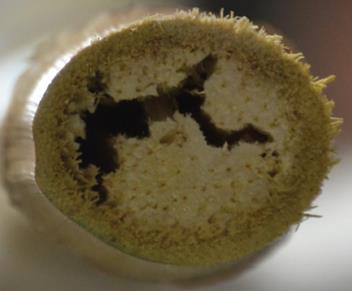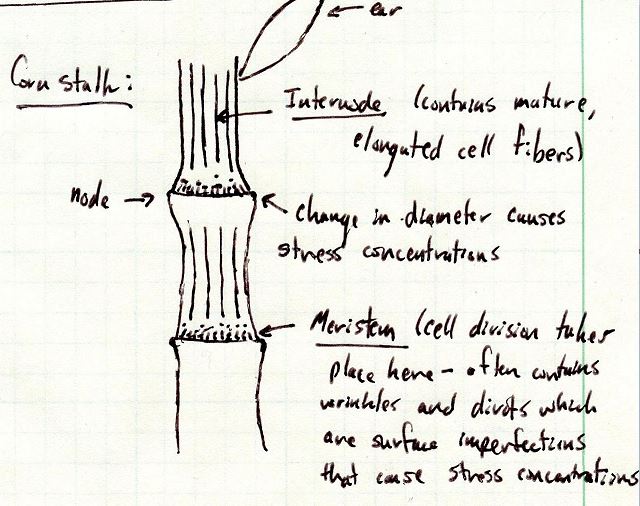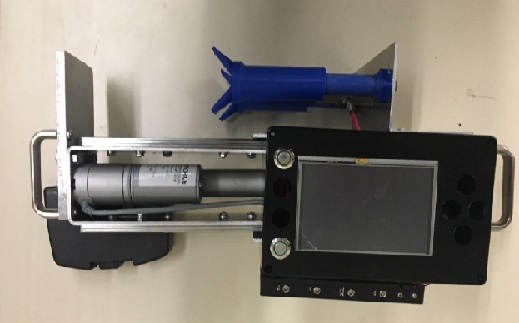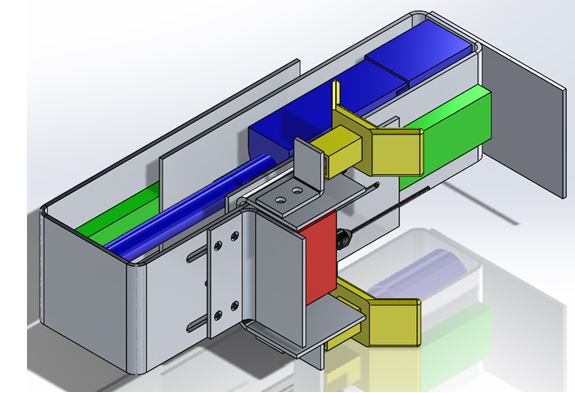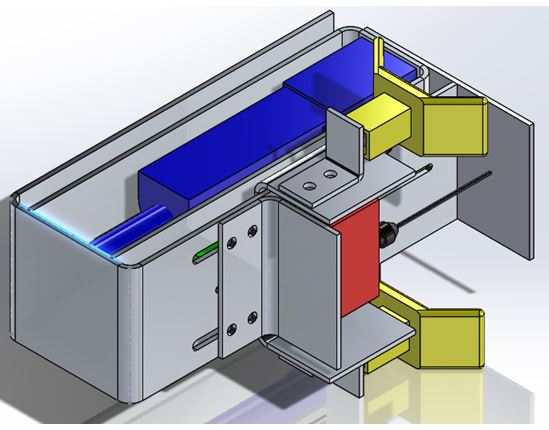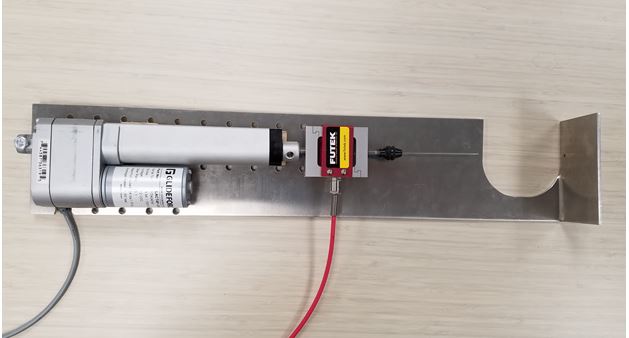Food Insecurity
| Team Name | Children of the Corn | |
| Sponsors | ||
| Team Members | ||
| Duration | Fall 2017 - Spring 2018 | |
| Client | Dr. Dan Robertson | |
| Faculty Advisers | Dr. Dan Robertson | |
| Mentor | Colton Bailey | |
Team Mission
It is our purpose to create a device that allows plant breeders to accurately measure stalk strength in an economically feasible and high throughput manner so they may breed for stronger stalks to prevent lodging. Our device will create a way to do non-destructive testing to obtain a strength value of corn stalks that is light, quick, and easy to use. By using a needle to measure the diameter and rind thickness of a cornstalk, our device is able to find the strength of a cornstalk using engineering principles quickly and accurately. From the testing we have done, our device is able to calculate the diameter and rind thickness using the force displacement curve generated.
Background[edit | edit source]
2016-2017
During the Fall semester of 2016 & the Spring semester of 2017 the team working on the Food Insecurities project created a device that measures the stalk strength of corn using the bending moment created by pushing the corn stalk over until it breaks. They were able to create a device that has since gone out in to the field and been used by seed research companies like Monsanto. Currently, there are very few ways to accurately measure the stalk strength of a plant and none of those are cost effective, non-destructive, and easy to use in the field. Currently the best way to measure stalk strength is through the use of a bender that bends the stalk until it breaks. The problem with this method is that once the stalk is broken the plant is no longer usable. While our device will not immediately solve the issue of stalk lodging, it will give plant breeders an easy quantifiable number for each stalk which can be used to create new varieties of corn that will have stronger stalks. Another benefit of our device is that, because it measures stalk diameter and rind thickness, it could be used by researchers who are doing different studies on corn.
2017-2018
The structure of a corn stalk has two parts, a outer layer called a rind and a inner layer called pith. Rind is high in cellulose and provides most of the structural support for the corn stalk. The pith is the soft inner layer of the corn stalk and provides the means to provide nutrient transportation throughout the corn stalk. Stalk lodging is defined as breakage of the stalk below the ear.Every year the annual loss to corn from stalk lodging is between 5%-25%, it can also cause an increased harvest time, drying costs, and can cause volunteer corn the next planting cycle.
The corn stalk grows at points called nodes, and it is just above these points where the highest stresses occur. It is at these points where we are trying to calculate the strength of the corn stalk.
Design Task[edit | edit source]
Problem Statement
Dr. Daniel Robertson of the Mechanical Engineering Department wants to create a smaller, quicker, easier to use device that uses non-destructive testing to measure the stalk strength of corn. This device must be quicker than the current device and easy for the operator to use all day.
Goals
1. The device must be able to be operated by one person and be able to take its measurements and show the results within 30 seconds.
2. The device must be able to last a full work day and must use non-destructive testing to measure the stalk strength.
3. A working device must be complete by the end of the Fall 2017 semester.
Design Specifications[edit | edit source]
When Comparing 3 different methods to accomplish our goals our team used a design matrix to rate each design in each category from 1 to 3. Where 1 was inadequate, 2 was met expectations, and 3 was excelled. We then totaled each categories score and the design with the highest score was deemed the best device.A more detailed list of our constraints and specifications can be seen below with the reason for each.
Design Process[edit | edit source]
Mechanical Components
Throughout this semester we went through many different iterations and prototype to come up with our final design pictured below in its open and closed configuration.
So far for the second semester of the project we have come a long way in developing new designs and prototypes. Using our design matrix, we designed to go with a out of line actuator design with the option of having it hand powered as well. Below is a CAD drawing of the current prototype will look like in its full extension.
Then below is a picture of what it will look like fully retracted.
A top view of what the final product will look like has been included below.
The design of our device uses a several key components - a linear actuator (blue), load cell (red), needle, stalk holder (yellow), and back plate. The Linear actuator is used to push the needle attached to the load cell through the stalk to gather data on force. The back plate is used as a support for the stalk allowing for more accurate force measurements. The back plate is also used as a absolute zero when measuring distance with the linear potentiometer attached to the actuator. This data is then graphed and shown on a touch screen on top of the device.
The Stalk Holders took quite a few iterations to get a point where they worked smoothly without binding.The two picture below show the final design for the stalk holders.The purpose of the nubs seen in the first picture is to lock the holder on to the shaft where a spring allows it to compress without coming completely apart.It is possible to see the channels in the second cut away picture.
Our first prototype is shown below, and while the components are the same as our current prototype, it has a fundamentally different design. As can be seen in the picture below, we have the actuator, load cell, and needle all connected in line with each other, with space around them for all the electrical components.
For our next iteration we got rid of the box and moved to a "backbone" design where we have one flat piece of metal with a bend at one end to act as a back plate and mount all components to it to cut down on size and weight of the device.
Electrical Components
The device uses a Raspberry Pi and a Arduino Controller to run the software and algorithms to create the force distance graph giving the stalk strength and diameter. The software is also able to track where the sample was taken using GPS and the plot number of the sample is able to be inputted. Within the device itself a motor controller will be used to control the actuator.
Experiment Design
In order to test our prototypes we will be using dried corn stalks that we collected in the fall and use the devices to poke the stalks. Our initial tests will be to see how well the device functions in a real world environment and if it can gather data and meet our speed requirements. If the device is able to meet these initial tests then we will move into testing the accuracy and precision of the data gathering by comparing the results from the device to tests done on the same stalks in a lab to measure the force and distance data graphs and comparing the results. For the tests we will be using multiple cornstalks with a variety of diameter sizes in order see how the device can handle different scenarios. Several things we will be looking for in the initial tests are: is there any deflection in the needle? Does the needle hit the center of the cornstalk? Is the method of holding the cornstalk in place effective? Is there any deflection in the back plate? Is the device moving fast enough to meet our speed requirements? The second round of testing will then be the fine tuning of the device and the algorithm which will plot the force vs distance data. The main question here is accuracy and that will be what we are looking for from this test.
Technical Data Sheets
Media:2017 Food insecurity Linear_Potentiometer_Specs.pdf
Media:2017 Food Insecurity Motor_Controller_Specs.pdf
Media:2017 Food Insecurity Arduino_Uno_Specs.pdf
Media:2017 Food Insecurity Raspberry_Pi_3_Specs.pdf
Media:2017 Food Insecurity Load_Cell_Specs.pdf
Media:2017 Food Insecurity LD_Linear_Actuator_Data_Sheet_1607.pdf
Project Learning[edit | edit source]
Software
Most of the software has already been developed by the previous device's team, however changes must be made to allow for how the force is gathered relative to the distance of the needle.The Diagram below shows the progression of data as it is collected and analyzed.
Fabrication
The team worked together and with the team mentor in the machine shop to begin creating the needles, chuck adapter, load cell adapter, and actuator connector that will be used in device. Any manufacturing unable to be completed by team members has been handled by Facilities at the University of Idaho or sent out to different machine shops for completion.
Project Designs
Before we could do our design matrix we had to come with different options in order to accomplish our goals, the 3 designs/prototypes below were the original 3 different designs we came up with. Below is a picture of our design matrix as well as the designs we were comparing.
Team Members[edit | edit source]
Josh Warnick
My name is Josh Warnick. I am a Mechanical Engineering student at the University of Idaho. I am from Lewiston Idaho and enjoy long walks on the beach and enjoying the outdoors.
Drew Owens
I’m an electrical engineering student interested in electromagnetics and antenna design. I’m from Coeur d’Alene where I met my wife and discovered a love for woodworking.
Spencer Hauck
I'm from Post Falls, Idaho. I'm a senior at the University of Idaho, seeking a B.S. in Mechanical Engineering. My desire is to use my knowledge to innovate new products that will improve the lives of others.
Justin Nesbitt
I am a Biological Engineering major from Meridian. As I have grown up, I have always enjoyed trying to figure out how things work and have been fairly successful at putting them back together again.
Additional Team Documents[edit | edit source]
Project Records
Meeting Agendas & Minutes
Agendas
File:Agendas for the Year Food Insecurity 2017.pdf
Minutes
File:Minutes Food Insecurity 2017.pdf
Presentations

